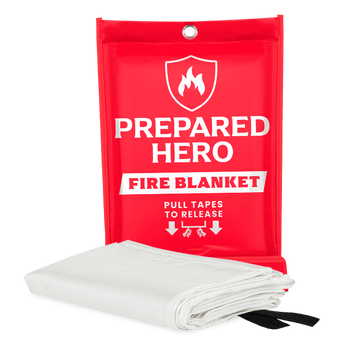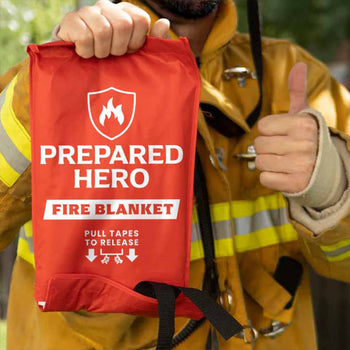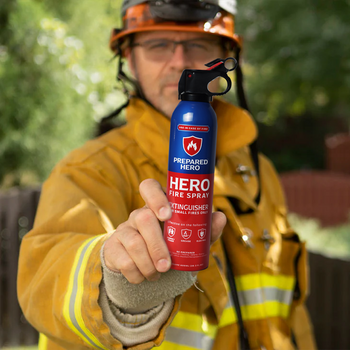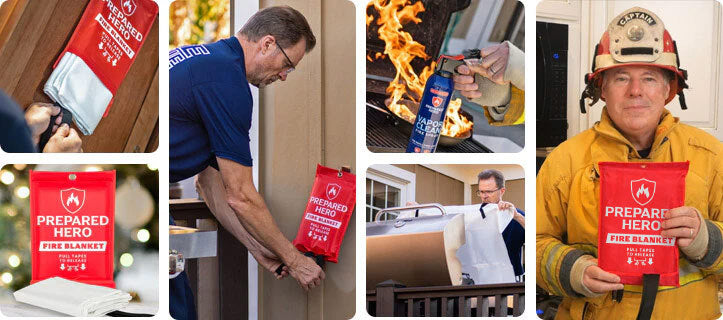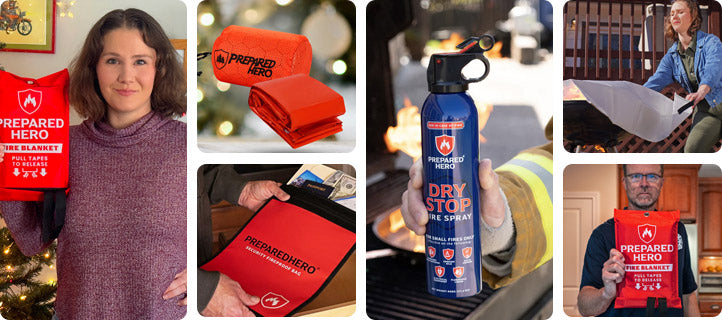A fire in an office or store can be devastating to people. Aside from death and property loss, people might...
As temperatures rise across the United States, wildfires become more life-threatening. Knowing what a Red Flag Warning and a Fire Weather Watch are keeps your family safe. These warnings are in place for many reasons, and we’ll talk about what they mean below. We’ll also discuss the safety measures you can take to prevent fire when these warnings are issued.
What Is a Red Flag Warning?

A Red Flag Warning is a weather alert issued by the National Weather Service (NWS) in the US. It means that warm temperatures, low humidity, and strong winds produce higher fire risks within 24 hours. Under this condition, a spark can lead to fast-spreading fires, especially in areas with dry vegetation.
The NWS issues these warnings based on specific local conditions, including vegetation type, topography, and distance from major water sources. They specifically consider daily vegetation moisture content, expected afternoon high temperature, minimum afternoon relative humidity, and daytime wind speed. Hence, what triggers a Red Flag Warning in a grassland might differ from that in a forested area.
In particular, a Red Flag Warning is issued when:
- Temperatures rise to 75°F (23.9°C) or more
- Humidity drops to 25% or lower
- Sustained winds average 15 mph or more
- Dry lightning strikes occur
Red Flag Warnings are important to firefighting agencies, especially after a drought or dry season. When a Red Flag Warning is issued, they prepare by adding field staff, setting up more equipment, and increasing response times. Residents are also encouraged to avoid activities that might start fires, such as mowing the lawn, grilling, or using fire pits. Local laws may also prohibit outdoor fires during a Red Flag Warning.
The NWS often issues a Fire Weather Watch before a Red Flag Warning. In a gist, this warns fire officials that conditions might be worse within 12 to 72 hours. It gives the public and fire agencies a heads-up for a potential Red Flag Warning.
Before a Red Flag Warning is issued, the NWS often puts out a Fire Weather Watch. This watch alerts fire officials that conditions might worsen in the coming days, typically within a 12 to 72-hour window. It gives agencies and the public a heads-up to stay alert for potential Red Flag conditions.
Historically, Red Flag Warnings have been around since the 1960s, and before digital alerts, they were communicated using actual flags. Some places still raise a physical red flag during these warnings. Nowadays, the alerts are widely broadcast via television, radio, and online platforms.
On October 29, 2019, the National Weather Service issued a rare Extreme Red Flag Warning for Southern California. According to the report, winds could top 80 mph and be the strongest in 12 years. The magnitude of wind gusts was a huge concern at that time because it was extreme in many places.
This Extreme Red Flag Warning is only issued when severely dangerous conditions exist (extremely strong winds, low humidity, and dry fuels). If you see this alert, take extra precautions and evacuate immediately when authorities tell you to do so.
Remember to take these warnings seriously, no matter where you live. Wildfires can start and spread quickly, posing risks to lives and properties. Being prepared means having a wildfire evacuation plan and a family bug out bag that includes food, water, and medicine.
What Is a Fire Weather Watch?

A Fire Weather Watch is a weather alert issued by the National Weather Service (NWS) when the area has been dry for a significant period, the National Fire Danger Rating System (NFDRS) is extremely high, and critical weather conditions are expected within the next 48 hours.
While it’s not as intense as a Red Flag Warning, you should pay attention to it. Just because it’s less intense doesn’t mean you can neglect it. Remember, wildfires can start quickly, and weather conditions can change abruptly.
Like a Red Flag Warning, a Fire Weather Watch is issued when:
- Temperatures rise to 75°F (23.9°C) or more
- Humidity drops to 25% or lower
- Sustained winds average 15 mph or more
The only difference is that a Red Flag Warning is issued when the said conditions are expected within 24 hours, while a Fire Weather Watch is issued within 48 hours. A Fire Weather Watch is issued before a Red Flag Warning. This alerts the general public and fire agencies that conditions will likely worsen within 12 to 72 hours.
What to Do During a Red Flag Warning and Fire Weather Watch

A Red Flag Warning means that there are higher fire risks. During this time, you should practice fire safety measures. From staying updated to packing a go kit, we’ve got you covered. Here’s what to do during a Red Flag Warning:
1. Stay Informed
Staying updated is crucial during a Red Flag Warning. Regularly check local weather reports and news outlets for information about your area. You can also follow your local fire department on social media or sign up for updates. States and cities follow different guidelines during a Red Flag Warning to stay informed about changes. Check the National Weather Service’s website for fire weather updates here.
2. Prepare Your Home
Preparing your house greatly reduces the risk of fire burning your property. Close all windows and doors in your house to prevent smoke from entering. Move flammable items outside, such as outdoor furniture and grills, into your home. Then, clear dead plants, trim bushes, and remove debris around your property.
3. Avoid Fire-Related Activities
Any fire-related activity during a Red Flag Warning can easily start a fire. Grilling, mowing the lawn, smoking, starting bonfires, and parking your vehicle on grass can produce sparks that can ignite dry vegetation. It’s best to avoid such activities during a Red Flag Warning.
If authorities allow you to use fire outdoors, contain the fire in burn barrels covered with a heavy metal cover, with holes less than 3/4 inch. Extinguish all outdoor fires using a fire blanket, fire spray, or fire extinguisher.
4. Pack Your Go Kit
Pack your go kit and keep it near your door so it’s easy to grab when you evacuate. According to the International Fire Chiefs Association, your go kit should include your personal wildland fire action plan, medicines and medical devices you need, and important documents, including your passport, driver’s license, birth certificate, and other legal documents.
What Not to Do During a Red Flag Warning

When a red flag warning is issued, it’s a clear signal that fire risks are higher than usual. During this time, it’s essential to be cautious and avoid activities that could spark a fire. Here’s a friendly reminder of what you should steer clear of to keep yourself and your community safe.
1. Don’t Light Open Flames
A Red Flag Warning isn’t the time for grilling, starting bonfires, or roasting marshmallows. Open flames can easily ignite dry vegetation. Even a small spark can turn into a huge fire. If you have plans to cook outdoors, postpone it until conditions improve.
2. Don’t Use Power Tools
Don’t use lawnmowers, chainsaws, or other power tools that can spark. While you might be tempted to do yard work, the risk isn’t worth it. Even simple tasks can lead to unintended fires. Remember, anything that can produce sparks during a Red Flag Warning is a no-go.
3. Don’t Smoke Outdoors
Keep your smoking indoors during a Red Flag Warning. Never toss burning cigarettes out of your car window because they can ignite dry vegetation and lead to wildfires. Always make sure your cigarettes are fully extinguished before throwing them. It’s a small change that can make a big difference.
4. Don’t Park on Dry Areas
Be careful of where you park your vehicle. Keep it off dry patches or areas with lots of vegetation. Hot exhaust pipes can quickly start a fire, so find a safe spot until the warning is lifted.
5. Don’t Burn Yard Debris
We suggest cleaning up your yard during a Red Flag Warning to prevent the debris from catching fire. However, burning them is a horrible idea. Leaves and branches burn easily, and they can spread the fire to your house. Find alternative ways to manage yard waste until conditions improve.
6. Don’t Use Fireworks
Fireworks are an ultimate no-no during Red Flag Warnings. The combination of heat and sparks can easily lead to fires. Save the fireworks for when the weather is more forgiving.
7. Don’t Leave Fires Unattended
Never leave the fire unattended, even if authorities allow you to burn stuff outdoors. Make sure someone else is watching the fire if you need to leave. Remember, a small flame can quickly get out of hand if left alone.
8. Don’t Use Fire Pits
Backyard fire pits can easily lead to larger fires if the weather’s dry, hot, and windy. Skip the fire pit, make sure nothing’s burning, and cover it until the warning is lifted.
9. Don’t Burn Trash
Burning trash is another thing you shouldn’t do during a Red Flag Warning. Whether it’s paper, plastic, or a mix of both, burning trash produces harmful fumes and creates sparks that can result in fires.
10. Don’t Ignore Warnings
Never ignore any local fire guidelines, updates, or restrictions. They’re issued for your family’s and community’s safety. Stay updated and follow what local fire departments tell you to do.
Conclusion
Red Flag Warnings and Fire Weather Watches warn the general public and fire agencies of increased fire risks. These alerts keep you, your family, and your community safe from fast-spreading fires. By knowing what the warnings mean and how to respond, you can make a huge difference. Keep yourself updated, prep your home, pack a go kit, and avoid any activities that can start a fire.
Keep fire safety tools on hand as well. It’s a great idea to have fire sprays, fire blankets, fire protection gloves, and fire extinguishers to contain fires before they get out of control. Let’s do our part and be prepared when those warnings come around. Stay safe, hero!


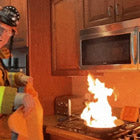 Fire
Fire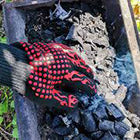 Safety
Safety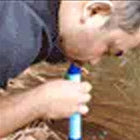 Survival
Survival Protection
Protection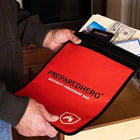 New
New
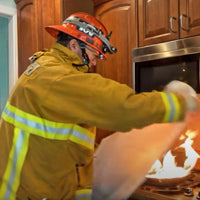 Fire
Fire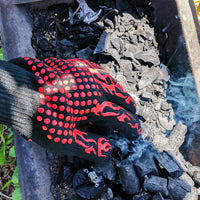 Safety
Safety Survival
Survival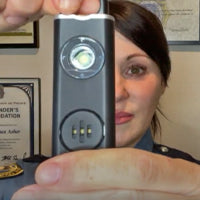 Protection
Protection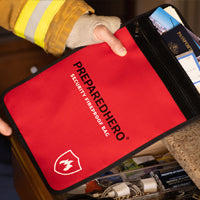 New
New